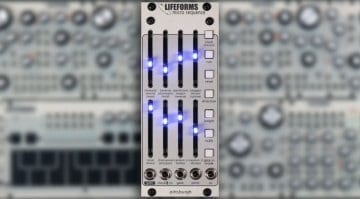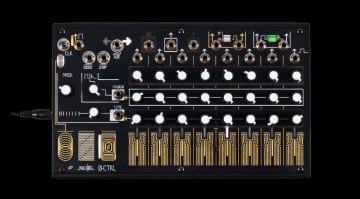XAOC Devices MOSKWA II: Classically styled 8-step Rotosequencer
Building on the original rotosequencer the MOSKWA II is a circle of 8-steps of CV and Gate/Trigger generation with creative controls, a built-in quantizer and slew limiter.
MOSKWA II 1965 Rotosequencer
What’s a Rotosequencer? Well, simply a sequencer that goes in circles. This started 10 years ago with the original MOSKWA and the new version maintains that look and functionality but has a number of key extras.
The basic sequencing is pretty obvious with 8-steps in a circle with 8 lit on/off buttons and 8 knobs to set the pitch. Set it running and the steps light up following the direction of their cyclic adventure. The eye is drawn to those three red knobs in the middle. One sets the tempo and can go up to audio rate for some additional tones. Another knob increases the range of the sequence, pushing the voltages apart. The third knob controls the Reset which sets how many steps are being used.
You are currently viewing a placeholder content from YouTube. To access the actual content, click the button below. Please note that doing so will share data with third-party providers.
Instead of the pendulum mode switches of the original they’ve added a patchable direction input so you can run it from external modulation. Not sure that’s an upgrade. What is new is the ability to set different parameters per step. Once a step is selected you can do things like add a slew with probability, skip it or change it to a trigger. Each step can also contain an 8-step micro-sequence, like a sequencer within a sequencer for creating complex patterns, ratchets, triggers, rhythms or swings. Again probability has something to say about it.
Moskwa II has two randomisation circuits that you can apply to sequences and parameters to get things moving in unexpected directions.
The internal quantizer is quite groovy because it has an entire mode to itself where you can punch in scales on the fly using the same circular interface. Same with the preset mode for storing and recalling your patterns. If you buy two you can link them together to lengthen the sequence.
XAOC has done a good job of making the interface engaging and simple to use. The circular motion is a lovely thing and removes the idea that a sequence has a start and a finish – this is simply music being generated and who knows when it will ever end.
OSTANKINO II
To go along with the Moskwa II they’ve a new version of Ostankino to provide a load more patch points and signal pathways. It includes individual outputs for each step, voltage control over transposition, slew, random and probability and more. It’s not necessary but is terribly useful.
Moskwa II is €350 and Ostankino II is €160, both are available now.
More information
Video
You are currently viewing a placeholder content from YouTube. To access the actual content, click the button below. Please note that doing so will share data with third-party providers.
This post contains affiliate links and/or widgets. When you buy a product via our affiliate partner, we receive a small commission that helps support what we do. Don’t worry, you pay the same price. Thanks for your support!
 5,0 / 5,0 |
5,0 / 5,0 | 






